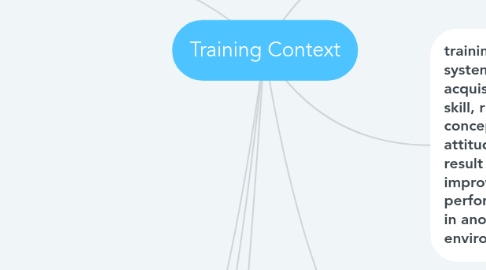
1. What do we know about trainers?
1.1. Their Roles?
1.1.1. Needs Analysis and Diagnosis
1.1.2. Determine Appropriate Training Approach
1.1.3. Program Design and Development
1.1.4. Develop Material Resources (Make)
1.1.5. Manage Internal Resources (Borrow)
1.1.6. Manage External Resources (Buy)
1.1.7. Individual Development Planning and Counseling
1.1.8. Job/Performance Related Training
1.1.9. Conduct Classroom Training
1.1.10. Group and Org Development
1.1.11. Training Research
1.1.12. Manage Working Relationships with Managers & Clients
1.1.13. Manage the Training and Development Function
1.1.14. Professional Self Development
1.2. Ethical Concerns Trainers Face?
1.2.1. voluntary consent
1.2.2. discrimination
1.2.3. cost effectiveness
1.2.4. accurate portrayal
1.2.5. competency in training
1.2.6. values
2. What do we Know about Types of Training & Training Methods?
2.1. Face to face classroom contact still most popular training method, but emerging alternatives are coming. Biggest concern with these alternatives is that they might be complicated enough to interfere with learning.
2.1.1. Other training types...
2.1.1.1. distance learning
2.1.1.2. virtual reality
2.1.1.3. computer based training
2.1.1.4. intelligent tutoring systems
2.1.1.5. web-based training
3. Training Challenges
3.1. Not enough: training program evaluation, training needs assessment, full potential of training use goes untapped (e.g., health training for employees).
4. Implications for Future Workplace Training Systems
4.1. The youth will be biggest source of entry level workers with higher education and training. However, the workforce will find difficulty using them because they are diverse, not experienced, and not numerous enough.
4.2. Hard to keep employees up to date with ever improving technology these days.
4.3. Shrinking workforce means having to choose employees for more diverse pools and giving those employees access to training. Some organizations are looking internationally for recruitment rather than locally.
4.4. To stay ahead of the curve, organizations have to deliver their training exactly on time - which is clearly difficult.
4.5. Questions an organization can ask to know if their training program was successful:
4.5.1. Where are the measurable results?
4.5.2. What can forum members learn from this practice?
4.5.3. Will this practice transfer to other organizations?
4.5.4. Is the practices trendy or actually applicable?
5. Scope of The Instructional Process
5.1. Training is an expensive endeavor.
6. training: systematic acquisition of skill, rules, concepts, or attitudes that result in improved performance in another environment
7. Changing Workplace and Workforce
7.1. changing entry level workers
7.1.1. new employees will come in slower and with less qualifications
7.1.2. less white people, more older people, and more women
7.2. Increasing Job Complexity
7.2.1. Automation means less un/semis skilled employees and more highly trained employees will be needed to design and program technology. Some organizations have tried to combat this by outsourcing the design and implementation of their training to other companies.

